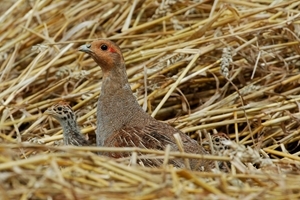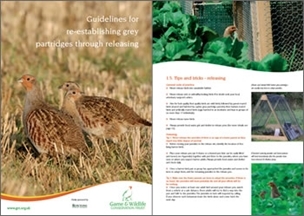Background
In the UK, numbers of grey partridges have declined by over 80% during the last 25 years, and in many parts of the country the species has become locally extinct. Concerns over the magnitude of the decline led the UK Government to place the species on the short list of the UK Biodiversity Action Plan (BAP) for which the Game & Wildlife Conservation Trust was appointed lead partner in 1996.
Contents
 The Grey Partridge Species Action Plan’s targets were to restore numbers from 65,000 pairs in 2005 to 90,000 pairs nationally by 2010, and to expand its 1990 range. Over the past 40 years, we have identified the reasons behind the decline of the grey partridge and devised a range of effective techniques for reversing its decline. The present guidelines provide specific advice to assist the recovery of the grey partridge where numbers have fallen below self-sustainable levels or where it no longer exists.
The Grey Partridge Species Action Plan’s targets were to restore numbers from 65,000 pairs in 2005 to 90,000 pairs nationally by 2010, and to expand its 1990 range. Over the past 40 years, we have identified the reasons behind the decline of the grey partridge and devised a range of effective techniques for reversing its decline. The present guidelines provide specific advice to assist the recovery of the grey partridge where numbers have fallen below self-sustainable levels or where it no longer exists.
The guidelines are based on our research between 2004 and 2006, when we investigated the best methods of re-establishing grey partridges through releasing, in areas where they have either almost or entirely disappeared, and where a suitable environment has been restored. The main points of this research were:
- We worked on 26 sites split between East Anglia and southern England, and followed the fates and breeding success of 2,023 released grey partridges, of which 131 were radio-tagged (at one site per region).
- We compared five different releasing techniques (bantam-reared and artificially-reared fostered juveniles, unfostered juveniles, family groups released in late autumn, and pairs released in spring).
- For the first six months after release, the survival of fostered birds was highest (20%) with no differences found between bantam-reared and artificially-reared juveniles, followed by autumn coveys (10%), spring pairs (9%) and unfostered juveniles (7%).
- For birds that managed to survive the first six months, the re-sighting rate after the next six months was much higher (36%), giving evidence of their adaptation to the wild.
- Of the birds that survived to the breeding season, on average 89% remained within 1.5 kilometres of the release site, indicating good site fidelity.
- The breeding success of released birds that survived until autumn averaged 49% for fostered birds, 31% for autumn coveys, 24% for spring pairs and 0% for unfostered juveniles.
- Brood sizes of released birds did not differ from those produced by wild birds in the same areas in autumn.
- Breeding success in southern England was roughly half what it was in East Anglia, probably because of less intensive predator management.
Our guidelines have been produced using the findings above combined with over 30 years of grey partridge research and practical experience. Through them, we seek to promote best practice in grey partridge re-establishment attempts, in line with the internationally accepted Guidelines for re-introductions produced by the International Union for Conservation of Nature (IUCN) and its Species Survival Commission (SSC), the Guidelines for the re-introduction of galliformes for conservation purposes of the IUCN/SSC galliform specialist groups and our summary of the IUCN/SSC guidelines. The techniques described in this document fulfil all legal requirements and are set out in two main parts: the first describes re-establishment procedures, the second rearing procedures.
Get your FREE guide from the GWCT Advisory team
Simply enter your email address below to download your essential free guide.
 What's inside your FREE guide
What's inside your FREE guide
✓ Background to releasing
✓ Guidelines for grey partridge re-establishment
✓ Measures needed for re-establishment
✓ Tips and tricks - releasing
✓ Husbandry practices
✓ Tips and tricks - rearing for release
✓ Summary of IUCN guidelines on re-introductions
*You may change your mind any time. For more information, see our Privacy Policy.